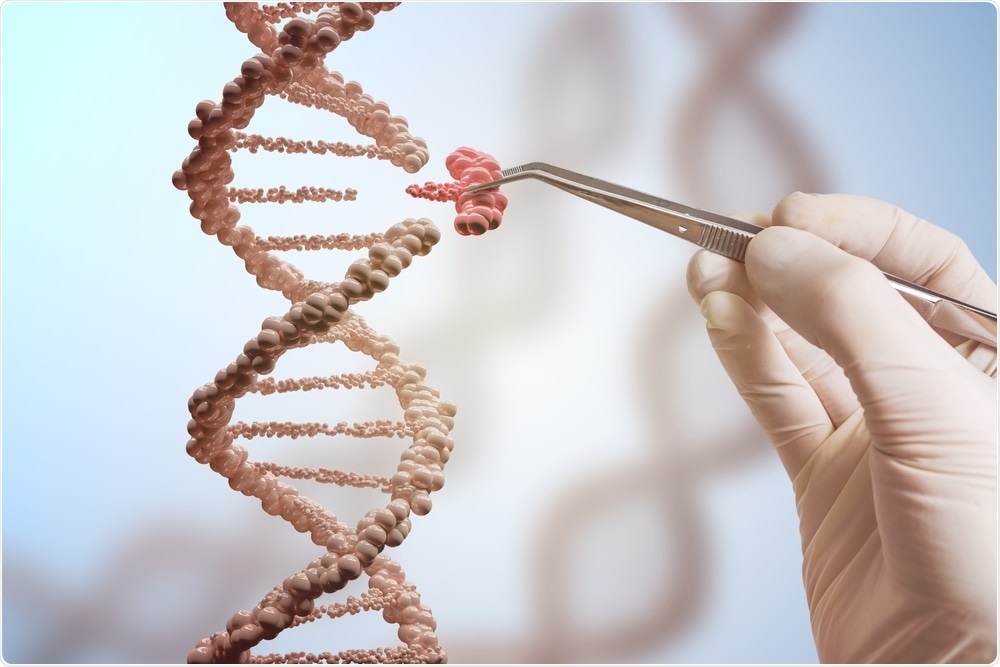A research team has used a novel method that could help resolve the issue of unnecessary genetic changes encountered in the CRISPR-Cas9 technique. This method enables the researchers to switch off gene-editing until it achieves crucial cell cycle phases, in which more precise repairs may probably take place.

Image Credit: vchal/Shutterstock.com
The investigators from Hiroshima University and Tokyo Medical and Dental University have published their study results in the Communications Biology journal. The study effectively showed a more accurate gene-editing as well as suppressed unintentional genetic insertions, deletions, or mutations, known as off-target effects.
While earlier techniques were designed that reported a minimal number of off-target effects connected with the CRISPR technology, these usually had lower editing efficiency, stated the team.
We aimed to develop the method to avoid the side effect called off-target effect which is one of the most challenging problems in the genome-editing field. Our method is like hitting two birds with one stone. We can improve the preciseness of genome editing and suppression of off-target effects at the same time.”
Wataru Nomura, Study Co-Author and Professor, Graduate School of Biomedical and Health Sciences, Hiroshima University
More control in gene-editing
The CRISPR-Cas9 technique has introduced a new frontier in gene editing as a simpler and cheaper tool. It serves as scissors and can cut the type of genetic material that needs to be modified. But the process can also produce off-target effects that restrict its application in the therapeutic fields.
The latest technique, designed to remove these off-target effects, functions by employing the anti-CRISPR protein, called AcrIIA4. This protein works similar to an “off switch” that ceases the genome editing activity of SpyCas9.
The team combined AcrIIA4 with the N terminal region of human Cdt1—a kind of gene that helps ensure that replication of DNA occurs only once for each cell division. Their objective was to deactivate gene editing until S and G2—stages of the cell cycle when homology-directed repair (HDR) is dominant.
HDR is one of the two DNA repair processes employed by organisms, together with non-homologous end joining (NHEJ). But among the two, HDR is the preferred technique since the repair depends on the existence of a pair of chromosome copies in every cell.
HDR uses the duplicate chromosome as a kind of template for repair. It does this to make gene editing more accurate in contrast to NHEJ that simply tends to join the broken ends of the DNA.
While HDR takes place during the G2 and S phases of the cell cycle, NHEJ works in all phases, specifically in G1—the initial phase of the interphase stage of the cycle where the cell develops to prepare for DNA replication.
The team observed that the amount of ArIIA4-Cdt1 fusion depends on the cell cycle. This fusion increases during the G1 phase of the cell cycle which prevents gene-editing from taking place and, and thus stops repairs through NHEJ. Meantime, it also reduces during the S, M, and G2 phases that follow.
The efficiency of HDR using AcrIIA4-Cdt1 was increased approximately by 4.0-fold compared to that using SpyCas9 alone. At target or off-target site 1 (HCN1 gene), the mutation ratio was decreased by 86.5%. Moreover, the mutation ratio at off-target site 2 (MFAP1 gene) was decreased from 8.5% to 0.6% using AcrIIA4-Cdt1.”
Study Researchers, Hiroshima University
The researchers continued, “Co-expression of SpyCas9 and AcrIIA4-Cdt1 not only increases the frequency of HDR but also suppresses off-target effects. Thus, the combination of SpyCas9 and AcrIIA4-Cdt1 is a cell cycle-dependent Cas9 activation system for accurate and efficient genome editing.”
Nomura added that the team wants to further enhance the accuracy of the system, so that it could be safely employed in the therapeutic field.
We envision to apply our system to other CRISPR/anti-CRISPR combinations as well as other CRISPR based gene editor such as base editors and targeted transcription mediators. Our ultimate goal is to develop a genome editing system which can be used safely in the medical therapeutic field.”
Wataru Nomura, Study Co-Author and Professor, Graduate School of Biomedical and Health Sciences, Hiroshima University
Source:
Journal reference:
Matsumoto, D., et al. (2020) A cell cycle-dependent CRISPR-Cas9 activation system based on an anti-CRISPR protein shows improved genome editing accuracy. Communications Biology. doi.org/10.1038/s42003-020-01340-2.